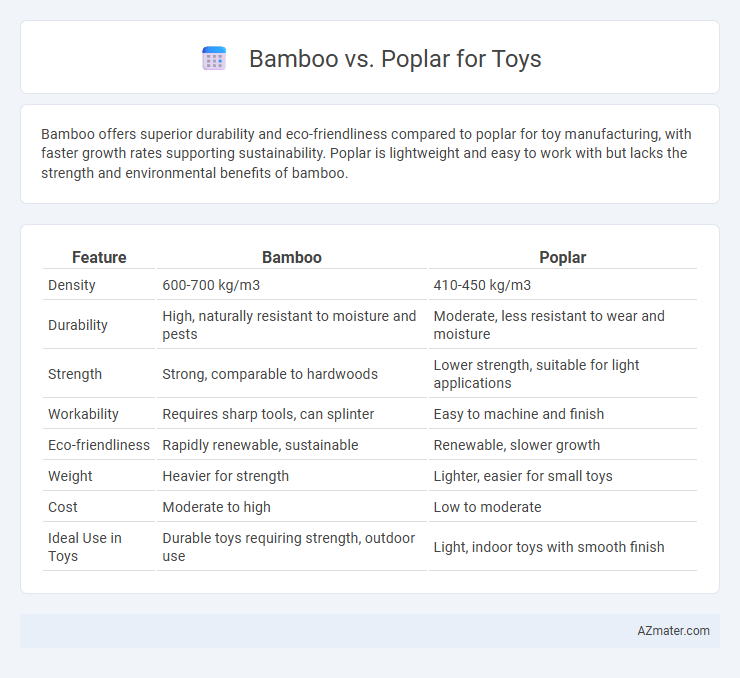Bamboo offers superior durability and eco-friendliness compared to poplar for toy manufacturing, with faster growth rates supporting sustainability. Poplar is lightweight and easy to work with but lacks the strength and environmental benefits of bamboo.
Table of Comparison
| Feature | Bamboo | Poplar |
|---|---|---|
| Density | 600-700 kg/m3 | 410-450 kg/m3 |
| Durability | High, naturally resistant to moisture and pests | Moderate, less resistant to wear and moisture |
| Strength | Strong, comparable to hardwoods | Lower strength, suitable for light applications |
| Workability | Requires sharp tools, can splinter | Easy to machine and finish |
| Eco-friendliness | Rapidly renewable, sustainable | Renewable, slower growth |
| Weight | Heavier for strength | Lighter, easier for small toys |
| Cost | Moderate to high | Low to moderate |
| Ideal Use in Toys | Durable toys requiring strength, outdoor use | Light, indoor toys with smooth finish |
Introduction to Bamboo and Poplar for Toy Making
Bamboo and poplar are popular materials in toy making due to their unique properties and sustainability. Bamboo is a fast-growing grass known for its strength, flexibility, and natural resistance to pests, making it ideal for durable, eco-friendly toys. Poplar wood is lightweight, soft, and easy to shape, offering a smooth finish suitable for detailed and painted wooden toys.
Sustainability and Environmental Impact
Bamboo outperforms poplar in sustainability due to its rapid growth rate, reaching maturity in 3-5 years compared to poplar's 8-10 years, which ensures quicker replenishment and less deforestation pressure. Bamboo's cultivation requires minimal pesticides and fertilizers, significantly reducing soil and water pollution relative to poplar farming that often depends on chemical inputs. Life cycle assessments indicate bamboo toys have a lower carbon footprint and higher biodegradability, making bamboo a more environmentally responsible choice than poplar for eco-conscious toy manufacturing.
Strength and Durability Comparison
Bamboo exhibits superior strength and durability compared to poplar, making it an ideal choice for toys subjected to heavy use and impact. Its natural fibers provide enhanced resistance to wear, bending, and breaking, while poplar, being a softer hardwood, tends to dent and degrade more quickly under stress. Bamboo's faster growth rate and sustainability further contribute to its appeal for long-lasting, eco-friendly toy production.
Safety and Toxicity Considerations
Bamboo offers superior safety for toys due to its natural antimicrobial properties and resistance to mold, reducing the risk of bacterial contamination. Poplar is generally non-toxic but may require careful chemical treatment to ensure it is free from harmful substances, which can affect overall toy safety. Both materials must comply with strict safety standards, but bamboo's inherent resistance to toxins makes it a safer choice for children's products.
Workability and Manufacturing Ease
Bamboo offers superior workability due to its natural flexibility and smooth surface, allowing for easy cutting, shaping, and sanding in toy manufacturing. Poplar is also favored for its ease of machining, featuring a fine, uniform texture that reduces tool wear and facilitates detailed carving. Both materials enable efficient production processes, but bamboo's rapid growth and sustainability provide cost-effective advantages in large-scale toy manufacturing.
Cost Differences: Bamboo vs Poplar
Bamboo generally costs more than poplar due to its faster growth rate and sustainable harvesting, leading to premium pricing in toy manufacturing. Poplar offers a more affordable option with lower material costs and easier workability, making it popular for budget-friendly toys. Manufacturers often weigh the durable, eco-friendly appeal of bamboo against the economic advantages of poplar for cost-effective production.
Aesthetic Qualities and Finishing
Bamboo offers a smooth, glossy finish with natural light tones that enhance the aesthetic appeal of toys, providing a modern and eco-friendly look. Poplar wood features a fine, even grain with a pale cream color that accepts paint and stains well, allowing for versatile and vibrant finishing options. Both materials enable high-quality, visually appealing toys, but bamboo's natural sheen contrasts with poplar's adaptability in custom finishes.
Common Uses in Toy Production
Bamboo and poplar are widely used in toy production due to their distinct characteristics. Bamboo, valued for its rapid growth and sustainability, is commonly used to create eco-friendly, durable toys such as building blocks, puzzles, and musical instruments. Poplar, known for its lightweight and smooth texture, is preferred for crafting detailed wooden toys, dollhouses, and model vehicles, offering ease of carving and painting.
Pros and Cons of Bamboo for Toys
Bamboo offers exceptional durability and natural antimicrobial properties, making it an ideal, eco-friendly material for toy manufacturing. Its rapid growth and sustainability reduce environmental impact, but bamboo toys can sometimes be heavier and more rigid compared to softer woods like poplar. However, bamboo's natural resistance to moisture and pests outweighs the slight compromise in flexibility, ensuring longer-lasting, safe toys for children.
Pros and Cons of Poplar for Toys
Poplar wood is lightweight and easy to work with, making it ideal for crafting detailed toys, but it lacks the durability of harder woods such as bamboo. Its smooth texture allows for fine finishes and painting, enhancing the aesthetic appeal of toys. However, poplar is softer and may dent or scratch more easily, which can reduce the longevity of toys subjected to rough play.

Infographic: Bamboo vs Poplar for Toy
 azmater.com
azmater.com